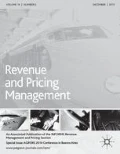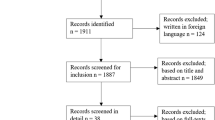Abstract
Consumers have cultivated a healthy appetite for luxury in their lives but as we move forward how are consumer behaviours changing towards luxury? This short article highlights a number of trends that have risen to prominence in the last 2 years as a result of the Global Financial Crisis and whether it is mercurial consumption or luxury for rent.
Similar content being viewed by others
THE CONCEPT OF LUXURY
When Marie Antoinette supposedly said let them eat cake, she was seen as a luxury junkie whose out of control spending grated on the poor and unfortunate French people. But today, cake has become one of our favourite luxury foods. A revolution has taken place where individuals in the world have got richer. Luxury is no longer the embrace of the Kings and Queens of France but the mass marketing phenomenon of everyday life. The concept of luxury is incredibly fluid and changes dramatically across time and culture. In the past it was associated with champagne, caviar, designer clothes and sports cars. Nowadays with increased affluence, luxury is a blurred genre that is no longer the preserve of the elite. More and more consumers have traded up as the old values of tradition and nobility have become less important. People are enjoying much more material comfort in comparison to previous generations, resulting in a trend of a cultural shift for personal fulfilment and aspiration through experience. Therefore, it could be argued that luxury is increasingly about experience and authenticity (Yeoman and McMahon-Beattie, 2010), rather than monetary value. This is not to say that luxury is about status, but luxury is more than monetary value. Indeed, they run side by side. This focus on aspiration and experience means increasing emphasis on personal transformation through, for example, well-being and travel. It means that consumers want to improve their life. This is what Danziger (2005), Israel (2003) and Gambler (1997) identify as the feminisation of luxury, where luxury has moved on from its male trophies and status symbols towards experience and indulgence. This is perhaps attributed to women's increasing buying power in society, which is driving luxury markets such as well-being, clothes and tourism. At the same time, the old world luxury of consumption and elitism stills prevails especially in emerging economies of China. More recently, the Global Financial Crisis has meant consumers have had to re-examine there priorities and as consequence, attitudes and behaviours towards luxury have changed.
CHANGING BEHAVIOURS
Luxury and quality
For many, luxury is often achieved not through the accumulation of multiple goods but through the purchase of a particular, special item. Many consumers aspire to access goods, experiences and treats that would normally not feature in one's day to day consumption. Yeoman and McMahon-Beattie (2010) note that there has being significant numbers across all ages and social grades who agree that they would rather own one good thing rather than lots of cheap things. One extracts the sense that at least a small dose of luxury is taken as a birthright by the mass of consumers and that millions are primed to upgrade to quality rather than accumulate quantity. The feature drives the evolution of premiumisation: we all grow less motivated by the ordinary. Data by the Future Foundation (2010) suggests that the youngest age groups are consistently the most aspirational – over half would pay significantly more for a car and over 40 per cent for a pair of jeans in a luxury category. However, there is also another trend at play here. Verifiable quality is playing an ever sharper role within consumer expectations. It is just not particularly fashionable to presume in favour of the pretty and the over-priced – as if that were collectively a guarantor of a luxury outcome. Across so many markets, recession strengthened the maximising instinct – the willingness to take time to scrutinise offers in search of both a quality and value-for-money result.
Luxury for rent
The appeal of renting luxury products instead of buying continues to rise. Nearly a quarter of 15–24s and over a fifth of 25–34s are favourable to the idea of getting access to luxury products by hiring or renting them according to research by the Future Foundation (2010). The renting trend chimes with another evolution in luxury consumption – that of the weakening appeal of showy, materialistic wealth and a growing intolerance for wasteful consumerism. Tracking data by the Future Foundation (2010) shows us that high levels of eco-sensitivity remain and these attitudes will naturally impact upon luxury purchasing and indulgence. Although an ultra-hedonistic type of luxury indulgence is still something that consumers will – at least occasionally – want to satisfy, certain luxury aspirations are undoubtedly subject to greater scrutiny and questioning now. Luxury in this decade naturally become a lot less noisy, a lot less ostentatious – but it remains a potent and almost universal motivation none the less.
As a consequence, luxury has now become so democratic that it is ubiquitously for rent. The growth of websites such as www.bagborroworsteal.com offers couture and designer handbags for rent – allowing a larger group of consumers a share in the luxury lifestyle, without the need for a luxury-sized salary. Bag, Borrow or Steal was first to market offering the concept of borrowing luxury products and is leading a revolution in the way consumers shop for designer goods or gain access to exclusive events/lifestyles. ‘Quintessentially’ (www.quintessentially.com), an international concierge service and members’ club offers customers access to first class airport lounges, designer fashion shows, nightclubs and exclusive events closed to the public for a membership fee ranging between UK £750 and £2500. You can rent a Ferrari or Aston Martin car for an evening from the Classic Car Club and connecting to auction sites like Ebay (www.ebay.com) and Portero (www.portero.com) where you can bid for second-hand luxury items for a fraction of the price-tag for new items. These services enable customers to ‘access the inaccessible’. For both emotional and practical reasons consumers are, on the margins, rejecting owning products in favour of renting them. This development indicates a shift in the consumer mindset towards the ownership of possessions and luxury items. Renting allows consumers to sporadically dip into the luxury lifestyle without paying the full (unaffordable for most) price for the privilege. Fractional living like this gives them a chance to adopt an alternative, more glamorous and stylish persona for a short period of time and indulge in celebrity lifestyle – all on a budget.
Mercurial consumption
Consumers are very aware of tariffs, even when they think about treats and indulgences. Searching for discounts is becoming a more commonly attractive behaviour and any negative or socially unappealing association in relation to bargain-hunting in luxury markets are. Flatters and Wilmott (2009) call this mercurial consumption in which consumers extensively search out for bargains. The use of technologies and websites such as www.farecast.com that advises travellers of the optimal time to purchase an airline ticket or price, or grabbing last minute offers from websites such as www.grabaseat.co.nz that offer last minute air travel deals to New Zealand consumers, or www.5pm.co.uk that offers diners the chance of discounted meals after 17:00 that evening. Technology and social media network enabling purchasing strategies, further accelerate this trend of mercurial consumption.
The discount club Little Emperors (www.littleemperors.com), offers customers concessions of up to 60 per cent from a range of luxury brands including Cartier and Jimmy Choo as well as discounts on experiences and services like holidays, chauffeuring and restaurants. Elsewhere on the internet, successful luxury shopping sites include www.vente-privee.com and www.Cocosa.com.
Exclusivity
One of their challenges for luxury brands is that they face the risk of being perceived as too accessible and losing their exclusive appeal. Appealing to the masses can be lucrative but luxury goods manufacturers also run the risk of, so to speak, disturbing their meaning-narrative. These brands have long been perceived as scarce and out of reach. Louis Vuitton (www.louisvuitton.com) has had to fight hard to preserve its image after thousands of fake copies of their handbags can now be found in almost any street market around the globe. Burberry (www.burberry.com) has suffered when somewhere along the line, the brand became the new status symbol for working-class youth. Luxury brands at the top end risk over-exposing themselves by expanding too far into the mass market and must find new ways to maintain their luxury credentials. In other words, they have to redefine ‘real luxury’ from mass luxury. The definition of luxury has also gradually expanded from material goods such as designer clothes and jewellery and many of the traditional luxury providers now face competition from new forms of luxury such as new types of lifestyle holidays, spa retreats and other ‘experience’ providers’.
New expressions
Consuming luxury in a more socially aware manner is a trend that is growing in importance. Luxury is becoming more closely aligned with deeper issues such as eco-awareness, intelligence, healthy and ethical lifestyles. The appeal of, say, a technologically superior Smartphone′s sophisticated game console that is focused on improving body or mind, personalised professional fitness services or rich and locally produced foods has been strengthened because of their associations with social values that are increasingly thought to be attractive, admirable and aspirational.
CONCLUDING REMARKS
As society becomes more wealthy the definition of luxury changes, making luxury more accessible to the masses but creating difficulty for luxury products to defend that exclusivity. Over the last decade, the concept of luxury has transformed itself from materialism to time and aspiration, making luxury more reachable and democratised. Smaller, affordable luxuries and premiumised products are strengthening their appeal as consumers continue to satisfy their need for regular treats and indulgences in their lives. At the same time, luxury products have set out to protect their exclusivity through premium pricing and authenticity.
References
Danziger, P.N. (2005) Let Them Eat Cake: Marketing Luxury to the Masses – As Well as the Classes. New York, USA: Dearborn Trading Publishing.
Flatters, P. and Wilmott, M. (2009) Understanding the post recession consumer. Harvard Business Review 87 (July–August): 106–112.
Future Foundation. (2010) Consuming luxury, www.futurefoundation.net, accessed 26 January 2010.
Gambler, P. (1997) Female Economy. Illinois, USA: University of Illinois Press.
Israel, B. (2003) Bachelor Girl: The Secret History of Single Women in the 20th Century. London: William Morrow and Co London.
Yeoman, I. and McMahon-Beattie, U. (2010) The changing meaning of luxury. In: I. Yeoman and U. McMahon-Beattie (eds.) Revenue Management: A Practical Pricing Perspective, Chapter 6, Basingstoke, UK: Palgrave MacMillan, pp. 62–85.
Author information
Authors and Affiliations
Corresponding author
Rights and permissions
About this article
Cite this article
Yeoman, I. The changing behaviours of luxury consumption. J Revenue Pricing Manag 10, 47–50 (2011). https://doi.org/10.1057/rpm.2010.43
Received:
Revised:
Published:
Issue Date:
DOI: https://doi.org/10.1057/rpm.2010.43




